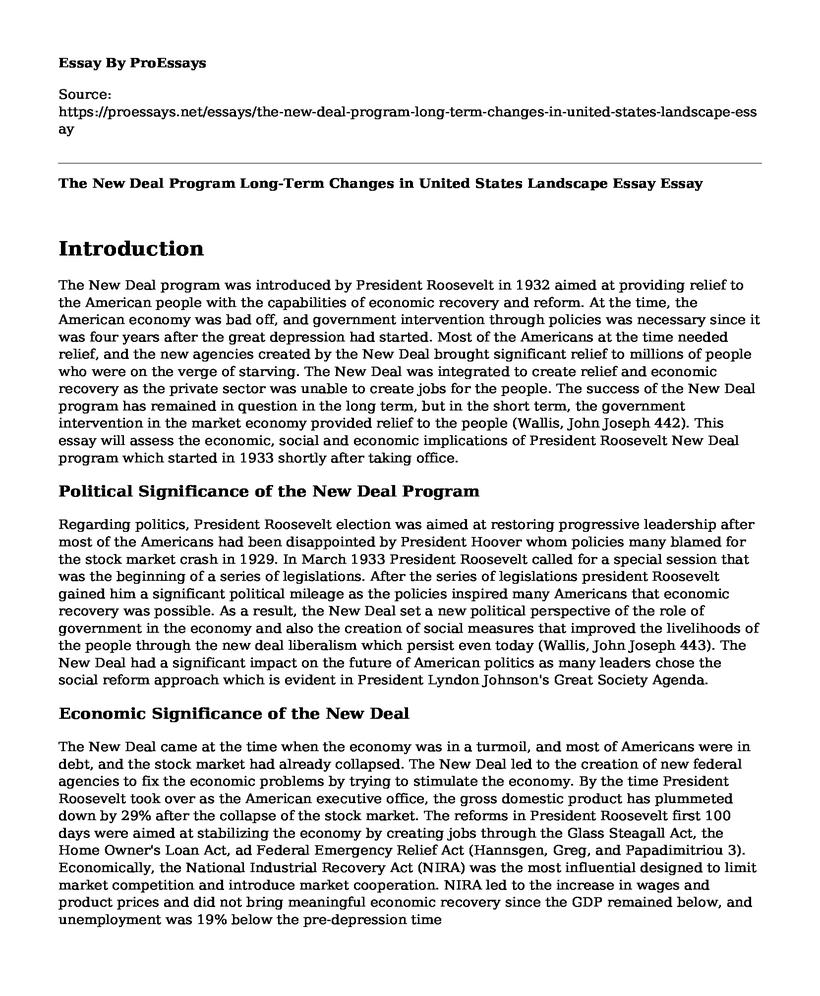Introduction
The New Deal program was introduced by President Roosevelt in 1932 aimed at providing relief to the American people with the capabilities of economic recovery and reform. At the time, the American economy was bad off, and government intervention through policies was necessary since it was four years after the great depression had started. Most of the Americans at the time needed relief, and the new agencies created by the New Deal brought significant relief to millions of people who were on the verge of starving. The New Deal was integrated to create relief and economic recovery as the private sector was unable to create jobs for the people. The success of the New Deal program has remained in question in the long term, but in the short term, the government intervention in the market economy provided relief to the people (Wallis, John Joseph 442). This essay will assess the economic, social and economic implications of President Roosevelt New Deal program which started in 1933 shortly after taking office.
Political Significance of the New Deal Program
Regarding politics, President Roosevelt election was aimed at restoring progressive leadership after most of the Americans had been disappointed by President Hoover whom policies many blamed for the stock market crash in 1929. In March 1933 President Roosevelt called for a special session that was the beginning of a series of legislations. After the series of legislations president Roosevelt gained him a significant political mileage as the policies inspired many Americans that economic recovery was possible. As a result, the New Deal set a new political perspective of the role of government in the economy and also the creation of social measures that improved the livelihoods of the people through the new deal liberalism which persist even today (Wallis, John Joseph 443). The New Deal had a significant impact on the future of American politics as many leaders chose the social reform approach which is evident in President Lyndon Johnson's Great Society Agenda.
Economic Significance of the New Deal
The New Deal came at the time when the economy was in a turmoil, and most of Americans were in debt, and the stock market had already collapsed. The New Deal led to the creation of new federal agencies to fix the economic problems by trying to stimulate the economy. By the time President Roosevelt took over as the American executive office, the gross domestic product has plummeted down by 29% after the collapse of the stock market. The reforms in President Roosevelt first 100 days were aimed at stabilizing the economy by creating jobs through the Glass Steagall Act, the Home Owner's Loan Act, ad Federal Emergency Relief Act (Hannsgen, Greg, and Papadimitriou 3). Economically, the National Industrial Recovery Act (NIRA) was the most influential designed to limit market competition and introduce market cooperation. NIRA led to the increase in wages and product prices and did not bring meaningful economic recovery since the GDP remained below, and unemployment was 19% below the pre-depression time
Social Significance of the New Deal
The New Deal program by President Roosevelt had far much social significance compared to its political and economic achievements. The New Deal changed the role of government to that of providing relief to people through social assistance programs (Hannsgen, Greg, and Papadimitriou 6). Most of the social assistance programs in place today have their roots in the New Deal era such as the pensions, farm subsidies, subsidized housing and unemployment insurance. The social security system was, therefore, the most crucial achievement of the New Deal legislation and continues to have a positive impact on many Americans (Wallis, John Joseph 450).
New Deal Conservative or Radical
The New Deal program tried to balance between a radical and conservative approach. The New Deal was radical in that the government was not used to interfering in the economic matters in the 1920s, but the New Deal provided adaptations that allowed the government to directly intervene in the economy. The New Deal was radical because the government directly started interfering in the people welfare, unlike the previous non-involvement system. The New Deal federal programs were revolutionary because they allowed the government to intervene in problems that were previously left to individuals and the local governments (Skocpol, Theda, and Kenneth Finegold 255).
Works Cited
Hannsgen, Greg, and Dimitri B. Papadimitriou. "Lessons from the New Deal: Did the New Deal Prolong or Worsen the Great Depression?." (2009).
Skocpol, Theda, and Kenneth Finegold. "State capacity and economic intervention in the early New Deal." Political science quarterly 97.2 (1982): 255-278.
Wallis, John Joseph. "Lessons from the political economy of the New Deal." Oxford Review of Economic Policy 26.3 (2010): 442-462.
Cite this page
The New Deal Program Long-Term Changes in United States Landscape Essay. (2022, Jul 19). Retrieved from https://proessays.net/essays/the-new-deal-program-long-term-changes-in-united-states-landscape-essay
If you are the original author of this essay and no longer wish to have it published on the ProEssays website, please click below to request its removal:
- The 8152nd Security Council Meeting - Paper Example
- Affordable Care Act Value Base Purchasing - Research Paper
- The Speech From the Throne 2015 Essay
- Essay Example on Global Communication: Exploring Cross-Border Connections
- Essay Example on Sacrifice Zones: Exploitation of People in West Virginia and Beyond
- Essay Example on Rising Cost of Healthcare: The Need for Innovative Solutions
- Essay Example on Women On Top: Managerial Strategies in Entrepreneur Sectors







